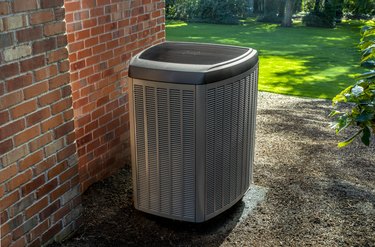
Although you probably don't give your HVAC system a lot of thought, somebody did. In order to increase the efficiency and life expectancy of heating and cooling units, homebuilders and HVAC technicians carefully calculate what size your HVAC components need to be. If they're too small, you won't be comfortable, and if they're too big, the system will put forth more energy than it needs to. To make sure your heat pump and other components are just right, HVAC installers compare the size of your home to the operating capacity, or tonnage, of your new HVAC system.
What Exactly Is Tonnage?
Video of the Day
In order to understand tonnage, you need to understand BTUs. "BTU" is short for the term "British thermal unit." A single BTU is the amount of heat generated by a single birthday candle. It's also the amount of heat needed to increase 1 pound of water by 1 degree Celsius. So, now you have a fun fact for Trivial Pursuit, but what does this really mean?
Video of the Day
In the HVAC industry, BTUs denote how much heat an air conditioner can remove from a room over the course of one hour. During the heating season, a BTU denotes how much warmth a heat pump can add to the room in that same hour.
In the United States, most HVAC manufacturers use the BTU designation to describe the capacity of their products. Outside the U.S., however, manufacturers tend to label their products using tons rather than BTUs. When they do, 1 ton is equivalent to 12,000 BTUs.
How Do I Determine Tonnage?
If you need to know the tonnage of your current heat pump, start by going outside and taking a look at the unit. Somewhere, there is a plaque containing all the information you need about your heat pump, including the model number. If you don't see a plaque, look for a door. Sometimes, HVAC makers place a sticker or label inside a service door where it will be protected from the elements.
Look closely at the model number. Within it, you're likely to see an even two-digit number combination. In residential units, the number you're most likely to find will fall between 18 and 60. This number represents the BTUs your unit puts out. To get the tonnage, simply divide the number by 12. If you see the number 18, for example, divide by 12 to get a rating of 1.5 tons.
Unfortunately, not every manufacturer does this. If you can't find the tonnage hidden in the model number, write it down and search for it online. The specifications for your particular unit are quite likely available somewhere on the internet. If not, call the manufacturer and ask. You can also consult your unit's user manual if you still have it.
Why Tonnage Matters
If it's time to replace your heat pump, you'll want to know the tonnage for several reasons. When replacing a heat pump after years of energy-efficient and faithful service, you may simply want to make sure you get a replacement as close as possible to what you currently have.
However, perhaps you've been living with a heat pump that's a little too small for your space. Maybe you've added on to your home or raised the ceilings. If you've made anything bigger, you'll likely need a bigger heat pump. Knowing the tonnage of your current unit gives you a good starting point.
The opposite is also true. If your pump was oversized from the start, the unit is likely quite inefficient and probably runs frequent short cycles, which can be hard on the appliance. It's also possible you need a smaller heat pump because you've purchased replacement windows or otherwise made your home more naturally efficient. Knowing what you have now gives you and your HVAC tech a good starting point.